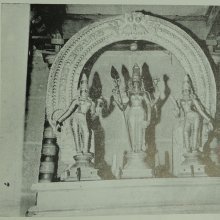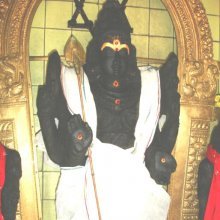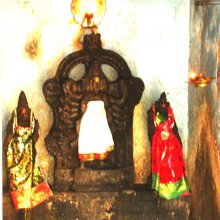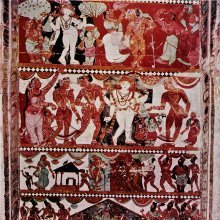Valli, Vallī: 35 definitions
Introduction:
Valli means something in Hinduism, Sanskrit, Buddhism, Pali, the history of ancient India, Marathi, Jainism, Prakrit, Hindi, biology, Tamil. If you want to know the exact meaning, history, etymology or English translation of this term then check out the descriptions on this page. Add your comment or reference to a book if you want to contribute to this summary article.
Images (photo gallery)
In Hinduism
Ayurveda (science of life)
Nighantu (Synonyms and Characteristics of Drugs and technical terms)
Source: Wisdom Library: Raj Nighantu1) Vallī (वल्ली) refers to a “creeper” (viz., a creeping plant), as mentioned in a list of eight synonyms for Vīrudh or Latā, according to the second chapter (dharaṇyādi-varga) of the 13th-century Raj Nighantu or Rājanighaṇṭu (an Ayurvedic encyclopedia). The Dharaṇyādi-varga covers the lands, soil, mountains, jungles and vegetation’s relations between trees [viz., Vallī] and plants and substances, with their various kinds.
2) Vallī (वल्ली) is also mentioned as a synonyme for Kaivartikā, a medicinal plant possibly identified with Ventilago madraspatana (red creeper) from the Rhamnaceae or “buckthorn family” of flowering plants, according to verse 3.120-121. Ṭhākur B.S. et al identify it with either Smilax species or Ventilago species. Nāḍkarṇī suggests Ventilago madraspatana Gaertn. (Rhamnaceae). Even after Nāḍkarṇī’s identification the creeper needs further verification
Source: WorldCat: Rāj nighaṇṭu1) Vallī (वल्ली) is another name for Atyamlaparṇī, an unidentified medicinal plant, according to verse 3.130-131 of the 13th-century Raj Nighantu or Rājanighaṇṭu. The third chapter (guḍūcyādi-varga) of this book contains climbers and creepers (vīrudh). Vaidyaka Śabda Sindhu equates Atyamlaparṇī with Amlaloṇī (Cāṅgerī) Oxalis corniculata Linn. (also known as creeping woodsorrel or sleeping beauty) but Chopra identifies Cāṅgerī as Rumex dentatus Linn. Together with the names Vallī and Atyamlaparṇī, there are a total of twenty-one Sanskrit synonyms identified for this plant.
2) Vallī (वल्ली) is also identified with Cavya, a medicinal plant possibly identified with Piper chaba Hunter, or “piper chilli” from the Piperaceae or “pepper” family of flowering plants, according to verse 6.41-42.— Note: According to the Bhāvaprakāśa, the fruit of Cavya [Cavikā] is said to be Gajapippalī, identified with either Scindapsus officinalis Schott, according to Chopra, Nadkarni and Roxburgh.—The sixth chapter (pippalyādi-varga) of this book enumerates ninety-five varieties of plants obtained from the market (paṇyauṣadhi). Together with the names Vallī and Cavya, there are a total of twelve Sanskrit synonyms identified for this plant.
Agriculture (Krishi) and Vrikshayurveda (study of Plant life)
Source: Shodhganga: Drumavichitrikarnam—Plant mutagenesis in ancient IndiaVallī (वल्ली) refers to a “creeper (type of plant)” which were commonly created using various bio-organical recipes for plant mutagenesis, according to the Vṛkṣāyurveda by Sūrapāla (1000 CE): an encyclopedic work dealing with the study of trees and the principles of ancient Indian agriculture.—Accordingly, “A big and strong mud pot should be filled with the mixture of mud and plenty of beef; and the Nerium indicum plant should be grown there with effort by watering profusely with cow dung and good quality beef. The above stated plant of Nerium indicum should then be shifted to a pit previously prepared by filling with cow bones, well-burnt ashes and then wetted by water mixed with beef. Thereafter, the plant should be fed with plenty of water mixed with beef. So treated, it is transformed into a creeper (vallī) to blossom profusely and perennially”.
Unclassified Ayurveda definitions
Source: Wisdom Library: Āyurveda and botanyVallī (वल्ली, “creeper”).—One the classifications of plants according to their stature. Vallīs are creepers with stems spreading on the ground (procumbent and decumbent). The term is used throughout Ayurvedic literature such as the Suśruta-saṃhitā and the Caraka-saṃhitā.
Vallī is listed as a classification for plants in the following sources:
The Manusmṛti 1.46-48 by Manu (also known as the Manusaṃhitā and Mānavadharmaśāstra).
Source: gurumukhi.ru: Ayurveda glossary of termsVallī (वल्ली):—Climbers; weak stemmed plants; A synonym of lata

Āyurveda (आयुर्वेद, ayurveda) is a branch of Indian science dealing with medicine, herbalism, taxology, anatomy, surgery, alchemy and related topics. Traditional practice of Āyurveda in ancient India dates back to at least the first millenium BC. Literature is commonly written in Sanskrit using various poetic metres.
Dharmashastra (religious law)
Source: Wisdom Library: Dharma-śāstraVallī (वल्ली) refers to “creepers” (eg., the guḍūcī). These plants are used to mark the boundary between two villages. The word is used throughout Dharmaśāstra literature such as the Manusmṛti. (See the Manubhāṣya, verse 8.247)

Dharmashastra (धर्मशास्त्र, dharmaśāstra) contains the instructions (shastra) regarding religious conduct of livelihood (dharma), ceremonies, jurisprudence (study of law) and more. It is categorized as smriti, an important and authoritative selection of books dealing with the Hindu lifestyle.
Pancaratra (worship of Nārāyaṇa)
Source: archive.org: Isvara Samhita Vol 5Vallī (वल्ली) refers to “areca nut” and is used in oblation offerings, according to verse 25.137-141a of the 8th-century Īśvarasaṃhitā. Accordingly, “... they [eg., vallī] are already cooked, filling the cooking vessels (sthālī) and dishes (śarāva) are to be kept in all broad frying vessels (ambarīṣa). They are to be placed on vessels (pātra) smeared with (within) ghee (ghṛta), are hot and are to be spread out there. They which are heated and made greasy with powdered peppers, jīraka and ghee are to be stirred again and again with ladle. They are to be kept in vessels covered with clothes etc”.

Pancaratra (पाञ्चरात्र, pāñcarātra) represents a tradition of Hinduism where Narayana is revered and worshipped. Closeley related to Vaishnavism, the Pancaratra literature includes various Agamas and tantras incorporating many Vaishnava philosophies.
Natyashastra (theatrics and dramaturgy)
Source: Shodhganga: The significance of the mūla-beras (natya)Valli refers to the “Goddess of chastity”, as mentioned in the Cilappatikāram: an ancient epic authored by Ilango Adigal representing an important piece of Tamil literature.—In Cilappatikāram, the kuṟavai-kūttu further changes into nilamakkal-kuṟavai. Vañcikkāṇṭam speaks of the kunṟṟakkuṟavai in the twenty-fourth chapter as people living in mountainous areas joining together and singing the praise of the goddess of chastity (Valli) and Lord Murukan.

Natyashastra (नाट्यशास्त्र, nāṭyaśāstra) refers to both the ancient Indian tradition (shastra) of performing arts, (natya—theatrics, drama, dance, music), as well as the name of a Sanskrit work dealing with these subjects. It also teaches the rules for composing Dramatic plays (nataka), construction and performance of Theater, and Poetic works (kavya).
Purana and Itihasa (epic history)
Source: WikiPedia: PuranasValli and Devasena.—The south-Indian manuscripts of the Sanskrit scripture Skanda Purana mentions Devasena and Valli as daughters of the god Vishnu in a previous life. Thus, Murugan is regarded as the son-in-law of Vishnu as their husband. An interpolation in the southern recensions of the scripture as well as the Kanda Purana (the Tamil version of the Sanskrit Skanda Purana) narrate the story of the marriage of the two maidens to Murugan.

The Purana (पुराण, purāṇas) refers to Sanskrit literature preserving ancient India’s vast cultural history, including historical legends, religious ceremonies, various arts and sciences. The eighteen mahapuranas total over 400,000 shlokas (metrical couplets) and date to at least several centuries BCE.
Shilpashastra (iconography)
Source: Shodhganga: The significance of the mūla-beras (śilpa)Valli is the name of a deity depicted at the Kamakshi Amman Temple in Kanchipuram, one of the most sacred places for the worship of the Goddess (Devī).—Valli and Deivānai, the consorts of Murukan, are found on the either sides of Murukan. Valli is represented in atibhaṅga with the right hand in dolā-hasta and the left hand in kaṭaka-hasta holding a flower. Deivānai is represented with the right hand in kaṭaka-hasta holding a flower and the left hand in dolā-hasta. Both these female images are found in atibhaṅga and sama-śiras (looking straight with heads at equal level).

Shilpashastra (शिल्पशास्त्र, śilpaśāstra) represents the ancient Indian science (shastra) of creative arts (shilpa) such as sculpture, iconography and painting. Closely related to Vastushastra (architecture), they often share the same literature.
Shaktism (Shakta philosophy)
Source: Google Books: ManthanabhairavatantramVallī (वल्ली) refers to a “vine”, according to the Ṣaṭsāhasrasaṃhitā, an expansion of the Kubjikāmatatantra: the earliest popular and most authoritative Tantra of the Kubjikā cult.—Accordingly, “[...] O mistress of the gods, the human flesh comes from the Creeper (latā), the Vine (vallī), and the Vehicle (vimāna). One should know that (the flesh of one) who has died by being dragged along (the ground) by bulls is called the Creeper. The Vine (is human flesh) that has been extracted (from a human corpse). The Vehicle (is the flesh of one) who has been torn apart by a spear (śūla). (These three are, respectively,) the inferior, middling and the best. [...]”.
Source: Brill: Śaivism and the Tantric Traditions (shaktism)Vallī (वल्ली) refers to “ (decorative) twining laces”, according to the King Vatsarāja’s Pūjāstuti called the Kāmasiddhistuti (also Vāmakeśvarīstuti), guiding one through the worship of the Goddess Nityā.—Accordingly, “[...] She has braided hair. Her limbs are adorned with bracelets, earrings, necklaces, twining laces (vallī), girdles, jewels, and anklets. Her clothes resemble Bandhūka flowers. She is full of affection, and the hue of her body is brightened up with saffron and sandal paste.. [...]”.

Shakta (शाक्त, śākta) or Shaktism (śāktism) represents a tradition of Hinduism where the Goddess (Devi) is revered and worshipped. Shakta literature includes a range of scriptures, including various Agamas and Tantras, although its roots may be traced back to the Vedas.
Jyotisha (astronomy and astrology)
Source: Wisdom Library: Brihat Samhita by VarahamihiraVallī (वल्ली) refers to “creepers”, according to the Bṛhatsaṃhitā (chapter 8), an encyclopedic Sanskrit work written by Varāhamihira mainly focusing on the science of ancient Indian astronomy astronomy (Jyotiṣa).—Accordingly, “The years of Jupiter (bṛhaspati) take their names from the several Nakṣatras in which he reappears after his conjunction with the Sun; and these names are identical with the names of the lunar months. [...] In the Bhādrapada year of Jupiter, the produce of creepers [i.e., vallī-ja] will thrive as well as the first crops; but the second crops will fail and there will be prosperity in some places and fear here and there”.

Jyotisha (ज्योतिष, jyotiṣa or jyotish) refers to ‘astronomy’ or “Vedic astrology” and represents the fifth of the six Vedangas (additional sciences to be studied along with the Vedas). Jyotisha concerns itself with the study and prediction of the movements of celestial bodies, in order to calculate the auspicious time for rituals and ceremonies.
General definition (in Hinduism)
Source: Wisdom Library: HinduismValli (वल्लि, “the earth”):—The Sanskrit name of one of the two wifes of Ṣaṇnukha, a form of Murugan (the embodiment of skilful action).
Source: WikiPedia: HinduismVaḷḷi (வள்ளி) (“Creeper, Sweet Potato Plant”) is a Hindu goddess and the consort of the god Kartikeya. Vaḷḷi is used to refer to many tribal or indigenous peoples' goddesses in Tamil Nadu and Kerala and by the Rodiya and Vedda peoples of Sri Lanka. In ancient times, the mountainous regions in South India were ruled by various tribes. The chief of the Kuravar tribe, Nambi Rajan and his wife prayed to the mountain god Murugan for a girl-child. Their prayers were answered, resulting in the birth of a girl named Valli. She grew up as the princess of the mountain tribe. Some myths state that Valli was born from a doe when a sage laid eyes on it during a momentary lapse in his meditation.
India history and geography
Source: archive.org: Geography in Ancient Indian inscriptionsVallī (वल्ली) is a word denoting a ‘village’ or ‘hamlet’ and can be seen as a synonym for grāma, often used in inscriptions.—Terms such as vallī are in many cases, associated with the names of the villages so as to become the ending part of the different place-names. Inscriptions throw light on the location of the villages in different ways. Firstly, they communicate us an idea about the country, the division and the sub-division to which these villages belonged. Secondly, the inscriptions provide information regarding theboundaries of the donated villages.
Source: Shodhganga: The significance of the mūla-beras (history)Valli is the name of a deity depicted at the Nellaiappar Temple at Tirunelveli, representing a sacred place for the worship of Śiva.—Valli Ammai is seen to the right of Subrahmaṇya with the left hand holding kaṭaka mudrā (in iconographic form), which is called kapittha-hasta in Bharatanatyam. The right hand is seen in dolā-hasta in both the arts. There is a liṅga in front of the standing Murukan and Nandi in front of the liṅga. Note: Vaḷḷi is seen sometimes riding a lion.
Source: Institut Français de Pondichéry: The Shaivite legends of Kanchipuramvaḷḷi (வள்ளி) (in Tamil) refers to one of the proper nouns mentioned in the Kanchipuranam, which narrates the Shaivite Legends of Kanchipuram—an ancient and sacred district in Tamil Nadu (India). The Kanchipuranam (mentioning vaḷḷi) reminds us that Kanchipuram represents an important seat of Hinduism where Vaishnavism and Shaivism have co-existed since ancient times.

The history of India traces the identification of countries, villages, towns and other regions of India, as well as mythology, zoology, royal dynasties, rulers, tribes, local festivities and traditions and regional languages. Ancient India enjoyed religious freedom and encourages the path of Dharma, a concept common to Buddhism, Hinduism, and Jainism.
Biology (plants and animals)
Source: Google Books: CRC World Dictionary (Regional names)1) Valli in India is the name of a plant defined with Caesalpinia crista in various botanical sources. This page contains potential references in Ayurveda, modern medicine, and other folk traditions or local practices It has the synonym Genista scandens Lour. (among others).
2) Valli is also identified with Vitex altissima It has the synonym Vitex alata Willd. (etc.).
Example references for further research on medicinal uses or toxicity (see latin names for full list):
· Flora of the Southeastern United States
· Phytochemistry (1707)
· Hortus Kewensis (1811)
· Phytotherapy research (2007)
· Bulletin de la Société Imperiale des Naturalistes de Moscou (1863)
· Phytologia (1971)
If you are looking for specific details regarding Valli, for example pregnancy safety, extract dosage, side effects, health benefits, diet and recipes, chemical composition, have a look at these references.

This sections includes definitions from the five kingdoms of living things: Animals, Plants, Fungi, Protists and Monera. It will include both the official binomial nomenclature (scientific names usually in Latin) as well as regional spellings and variants.
Languages of India and abroad
Pali-English dictionary
Source: BuddhaSasana: Concise Pali-English Dictionaryvalli : (f.) a creeper.
Source: Sutta: The Pali Text Society's Pali-English DictionaryVallī, (f.) (cp. Sk. vallī; for etym. see valaya) 1. a climbing plant, a creeper Vin. III, 144; J. V, 37; VI, 536; VvA. 147, 335 (here as a root?).—santānaka° a long, spreading creeper VvA. 94, 162.—2. a reed or rush used as a string or rope for binding or tying (esp. in building), bast (?) M. I, 190 (Neumann, “Binse”); J. III, 52 (satta rohita macche uddharitvā valliyā āvuṇitvā netvā etc.), 333 (in similar connection); DhA. III, 118.—3. in kaṇṇa° the lobe of the ear Mhvs 25, 94.—The compn form of vallī is valli°.

Pali is the language of the Tipiṭaka, which is the sacred canon of Theravāda Buddhism and contains much of the Buddha’s speech. Closeley related to Sanskrit, both languages are used interchangeably between religions.
Marathi-English dictionary
Source: DDSA: The Molesworth Marathi and English Dictionaryvallī (वल्ली).—m (Or valī) A saint or reverend person in general. 2 fig. (Because devotees are privileged.) A wild, wilful, lawless fellow, a libertine.
--- OR ---
vallī (वल्ली).—f (S) A climbing or creeping plant generally. 2 In algebra &c. A series.
Source: DDSA: The Aryabhusan school dictionary, Marathi-Englishvallī (वल्ली).—f A creeping plant. m A saint. Fig. A libertine.
Marathi is an Indo-European language having over 70 million native speakers people in (predominantly) Maharashtra India. Marathi, like many other Indo-Aryan languages, evolved from early forms of Prakrit, which itself is a subset of Sanskrit, one of the most ancient languages of the world.
Sanskrit dictionary
Source: DDSA: The practical Sanskrit-English dictionaryValli (वल्लि).—f. [vall-in Uṇādi-sūtra 4.135]
1) A creeper, creeping or winding plant; भूतेशस्य भुजङ्गवल्लिवलयस्रङ्नद्धजूटा जटाः (bhūteśasya bhujaṅgavallivalayasraṅnaddhajūṭā jaṭāḥ) Mālatīmādhava (Bombay) 1.2.
2) The earth.
--- OR ---
Vallī (वल्ली).—f. A creeping plant, winding plant, creeper.
Source: Cologne Digital Sanskrit Dictionaries: Shabda-Sagara Sanskrit-English DictionaryValli (वल्लि).—f. (-lliḥ or llī) 1. A creeper, a climbing or creeping plant. f.
(-lliḥ) The earth. f. (-llī) A plant, (Ligusticum ajwaen.) E. vall to cover, in aff., and ṅīp occasionally added.
Source: Cologne Digital Sanskrit Dictionaries: Benfey Sanskrit-English DictionaryValli (वल्लि).—vallīf. I., and vallī, A creeper, [Mānavadharmaśāstra] 1, 48 (lī); [Pañcatantra] 229, 9; [Bhartṛhari, (ed. Bohlen.)] 3, 23 (lī). Ii. valli, The earth. Iii. lī, A plant, Ligusticum ajwaen.
Source: Cologne Digital Sanskrit Dictionaries: Cappeller Sanskrit-English DictionaryValli (वल्लि).—[feminine] the same.
--- OR ---
Vallī (वल्ली).—[feminine] the same.
Source: Cologne Digital Sanskrit Dictionaries: Monier-Williams Sanskrit-English Dictionary1) Valli (वल्लि):—[from vall] f. the earth, [cf. Lexicographers, esp. such as amarasiṃha, halāyudha, hemacandra, etc.] (mostly mc. and in [compound] for vallī).
2) Vallī (वल्ली):—[from vall] f. (or valli q.v.) a creeper, creeping plant (often [figuratively] applied to arms, eyebrows, lightning etc.), [Manu-smṛti; Mahābhārata] etc.
3) [v.s. ...] a class of medicinal plants (= vidārī, sārivā, rajanī, and guḍucī), [Suśruta]
4) [v.s. ...] Name of various other plants ([especially] = aja-modā, kaivartikā, and cavya), [cf. Lexicographers, esp. such as amarasiṃha, halāyudha, hemacandra, etc.]
5) [v.s. ...] (only ī) Name of the sections of [particular] Upaniṣads (e.g. of the Kaṭha)
6) [v.s. ...] = phala-vallī (q.v.), [Āryabhaṭa [Scholiast or Commentator]]
Source: Cologne Digital Sanskrit Dictionaries: Yates Sanskrit-English DictionaryValli (वल्लि):—[(lliḥ-llī)] 2. 3. f. A creeper; the earth; ligustum.
Source: DDSA: Paia-sadda-mahannavo; a comprehensive Prakrit Hindi dictionary (S)Valli (वल्लि) in the Sanskrit language is related to the Prakrit words: Valli, Vallī, Vellā.
[Sanskrit to German]
Sanskrit, also spelled संस्कृतम् (saṃskṛtam), is an ancient language of India commonly seen as the grandmother of the Indo-European language family (even English!). Closely allied with Prakrit and Pali, Sanskrit is more exhaustive in both grammar and terms and has the most extensive collection of literature in the world, greatly surpassing its sister-languages Greek and Latin.
Hindi dictionary
Source: DDSA: A practical Hindi-English dictionaryVallī (वल्ली):—(nf) a creeper, creeping plant.
...
Prakrit-English dictionary
Source: DDSA: Paia-sadda-mahannavo; a comprehensive Prakrit Hindi dictionary1) Valli (वल्लि) in the Prakrit language is related to the Sanskrit word: Valli.
2) Vallī (वल्ली) also relates to the Sanskrit word: Vallī.
Prakrit is an ancient language closely associated with both Pali and Sanskrit. Jain literature is often composed in this language or sub-dialects, such as the Agamas and their commentaries which are written in Ardhamagadhi and Maharashtri Prakrit. The earliest extant texts can be dated to as early as the 4th century BCE although core portions might be older.
Kannada-English dictionary
Source: Alar: Kannada-English corpusValli (ವಲ್ಲಿ):—[noun] a loose, oblong garment used by men to cover the upper part of the body or put just on the shoulder, over the outer garment.
--- OR ---
Valli (ವಲ್ಲಿ):—
1) [noun] any creeper or climbing plant; a climber.
2) [noun] the earth.
Kannada is a Dravidian language (as opposed to the Indo-European language family) mainly spoken in the southwestern region of India.
Tamil dictionary
Source: DDSA: University of Madras: Tamil LexiconValli (வல்லி) noun < வல்¹. [val¹.] See வல்லான் [vallan], 4. வல்லினாற் பயன்கொள்வான் வல்லி [vallinar payankolvan valli] (வீரசோழீயம் தத். [virasozhiyam thath.] 3).
--- OR ---
Valli (வல்லி) noun < vallī.
1. Creeper; கொடி. (பிங்கலகண்டு) வல்லியனையாள் [kodi. (pingalagandu) valliyanaiyal] (புறப்பொருள்வெண்பாமாலை [purapporulvenpamalai] 12, பெண்பாற். [penpar.] 13, உரை [urai]).
2. A creeper with bulbous roots; கொடி வகை. [kodi vagai.]
3. Medicinal plant; மருந்துச்செடி. (சூடாமணிநிகண்டு) [marunthuchedi. (sudamaninigandu)]
4. Young woman, lady; இளம்பெண். வல்லியை யுயிர்த்த நிலமங்கை [ilamben. valliyai yuyirtha nilamangai] (கம்பராமாயணம் கோலங். [kambaramayanam kolang.] 24).
5. A wife of Skanda; முருகக்கடவுளின் தேவியாகிய வள்ளலார்சாத்திரம்ி யம்மை. (சூடாமணிநிகண்டு) [murugakkadavulin theviyagiya valli yammai. (sudamaninigandu)]
6. Fetters; கால்விலங்கு. கானி மிர்த்தாற் கண்பரிப வல்லியோ [kalvilangu. kani mirthar kanparipa valliyo] (பெருந்தொகை [peruntho.] 516).
7. Upaṇiṣad; உபநிடதம். [upanidatham.] (W.)
8. Banner, standard; பதாகை. (உரிச்சொல்நிகண்டு) [pathagai. (uricholnigandu)]
9. Battle-of-Plassey tree. See பலாசம்¹ [palasam¹],
3. 10. A plant. See புன்முருக்கு. (வைத்திய மலையகராதி) [punmurukku. (vaithiya malaiyagarathi)]
11. cf. நாகவல்லி. [nagavalli.] Marriage; கலியாணம். (யாழ்ப்பாணத்து மானிப்பாயகராதி) [kaliyanam. (yazhppanathu manippayagarathi)]
--- OR ---
Valli (வல்லி) noun See வல்லியம்³. (சூடாமணிநிகண்டு) [valliyam³. (sudamaninigandu)]
--- OR ---
Valli (வல்லி) noun < வல்². [val².] Quickness, speed; விரைவு. (சூடாமணிநிகண்டு) [viraivu. (sudamaninigandu)]
--- OR ---
Valli (வல்லி) noun cf. வல்லூரம். [valluram.] Removal, separation; பிரிகை. (பிங்கலகண்டு) [pirigai. (pingalagandu)]
--- OR ---
Valli (வல்லி) noun cf. vallalarsathiram A standard measure; அளவுவகை. [alavuvagai.] (W.)
--- OR ---
Vaḷḷi (வள்ளி) noun < vallī.
1. Climber, creeper; கொடி. வாடிய வள்ளலார்சாத்திரம்ி முதலரிந் தற்று [kodi. vadiya valli muthalarin tharru] (திருக்குறள் [thirukkural], 1304).
2. A plant, Convolvulus batatas; கொடிவகை. [kodivagai.] (W.)
3. Panicled bindweed. See நிலப்பூசணி. [nilappusani.] (M. M.)
4. Stalk, stem; தண்டு. [thandu.]
5. Streak, line, row; கொடிபோன்று தொடர்ந் திருப்பது. மேகவள்ளி [kodiponru thodarn thiruppathu. megavalli] (தொல். பொ. [thol. po.] 88, உரை [urai]).
6. Armlet, bracelet, wristlet; கைவளை. ஆம்பல் வள்ளலார்சாத்திரம்ித்தொடிக்கை [kaivalai. ambal vallithodikkai] (புறநானூறு [purananuru] 63).
7. Figures drawn on the breasts and arms of young women; தொய்யிற் கொடி. வண்டே யிழையே வள்ளலார்சாத்திரம்ி பூவே [thoyyir kodi. vande yizhaiye valli puve] (தொல். பொ. [thol. po.] 95).
8. See வள்ளலார்சாத்திரம்ித்தண்டை. [vallithandai.] (W.)
9. A wife of Skanda; முருகக் கடவுளின்தேவி. குறவர் மடமகள் . . . வள்ளலார்சாத்திரம்ியொடு [murugak kadavulinthevi. kuravar madamagal . . . valliyodu] (பத்துப்பாட்டு [pathuppattu] 101).
10. Woman of the hilly tracts; குறிஞ்சிநிலப் பெண். வள்ளலார்சாத்திரம்ிமருங்குல் [kurinchinilap pen. vallimarungul] (திருக்கோவையார் [thirukkovaiyar] 128).
11. (Puṟap.) Theme describing the veṟi-y-āṭal of hill women possessed by Murukaṉ; முருகக்கடவுட்கு மகளிர் மனநெகிழ்ந்து வெறி யாடுதலைக் கூறும் புறத்துறை. [murugakkadavudku magalir mananegizhnthu veri yaduthalaig kurum purathurai.] (புறப்பொருள்வெண்பாமாலை [purapporulvenpamalai] 9, 41.)
12. A kind of dance of hill women; குறிஞ்சிமகளிர் கூத்துவகை. [kurinchimagalir kuthuvagai.] (தொல். பொ. [thol. po.] 60, உரை. [urai.])
--- OR ---
Vaḷḷi (வள்ளி) noun < வண்-மை. [van-mai.] Moon; சந்தி ரன். [santhi ran.] (தொல். பொ. [thol. po.] 88, உரை. [urai.])
Tamil is an ancient language of India from the Dravidian family spoken by roughly 250 million people mainly in southern India and Sri Lanka.
See also (Relevant definitions)
Starts with (+121): Val-ittukurri, Valli muritali, Valli pullu, Valli uzinna, Valli Vihara, Valli-ammaikuttam, Valli-ankolam, Valli-caniram, Valli-k-kantam, Valli-kalyana-sundara, Valli-muritali, Valli-murukka, Valli-pala, Valli-palasa, Valli-teregam, Valli-upu-dal, Valli-upu-dali, Vallia-manga-nari, Vallia-tsjori-valli, Valliayai.
Ends with (+509): Aakashavalli, Aamaradaavalli, Aangaaravalli, Acatsja-valli, Acatsjavalli, Adambuvalli, Agamakalpavalli, Ahivalli, Akaca-valli, Akacavalli, Akashavalli, Akasvalli, Akaya valli, Akaya-valli, Akila-kalavalli, Akkivalli, Alakavalli, Alarvalli, Alvalli, Amarad-valli.
Full-text (+488): Vallija, Pattravalli, Tambulavalli, Mahavalli, Angaravalli, Carkkarai-valli, Nagavalli, Vallikoti, Valliyammai, Suvalli, Akashavalli, Nakavalli, Vallittantu, Vallikkantam, Taittiriya, Anghrivalli, Parnavalli, Tiktavalli, Omavalli, Tagaravalli.
Relevant text
Search found 63 books and stories containing Valli, Vallī, Vaḷḷi; (plurals include: Vallis, Vallīs, Vaḷḷis). You can also click to the full overview containing English textual excerpts. Below are direct links for the most relevant articles:
Taittiriya Upanishad Bhashya Vartika (by R. Balasubramanian)
Verse 2.750 < [Book 2 - Brahmavallī]
Verse 2.749 < [Book 2 - Brahmavallī]
Verse 2.748 < [Book 2 - Brahmavallī]
Katha Upanishad with Shankara’s Commentary (by S. Sitarama Sastri)
Verse 1.3.16 < [Adyaya I, Valli III - The parable of the chariot]
Verse 2.3.17 < [Adyaya II, Valli III - The theory of Karma and Rebirth]
Verse 1.2.25 < [Adyaya I, Valli II - The pursuit of Knowledge and Yoga]
Amarakoshodghatana of Kshirasvamin (study) (by A. Yamuna Devi)
Flora (2): Basic Classification of Plants < [Chapter 5 - Aspects of Nature]
Garga Samhita (English) (by Danavir Goswami)
Verse 4.19.6 < [Chapter 19 - A Thousand Names of Srī Yamunā]
Verse 2.16.34 < [Chapter 16 - The Worship of Tulasī]
Verse 2.19.33 < [Chapter 19 - The Rāsa-dance Pastime]
Concept of Oneness in the Upanishads (study) (by Chandra Shekhar Upadhyaya)
Concept of Oneness in Kaṭha Upaniṣad < [Chapter 4 - Concept of Oneness in Yajurvedic Upaniṣads]
Concept of Oneness in Taittirīya Upaniṣad < [Chapter 4 - Concept of Oneness in Yajurvedic Upaniṣads]
Shrimad Bhagavad-gita (by Narayana Gosvami)
Verse 9.21 < [Chapter 9 - Rāja-guhya-yoga (Yoga through the most Confidential Knowledge)]
Verse 2.29 < [Chapter 2 - Sāṅkhya-yoga (Yoga through distinguishing the Soul from the Body)]
Re-establishing the Doctrine of Parakīyā < [Introduction (to the Hindi edition)]





